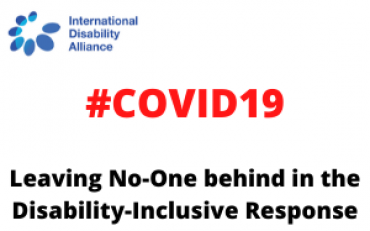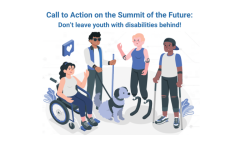This is one story as part of the Voices of People with Disabilities during COVID19 Outbreak series.
Names have been changed to protect the individuals mentioned in the story.
Karabo is a single mother who has two sons with disabilities. She lives in a suburban area in South Africa, where the majority of the population is Black and Indian and have a low income. Karabo is currently using crutches, meaning she is temporarily disabled.
Her younger son is 13-year-old and is autistic, nonverbal and only communicates through gestures. Her older son, Bandile, is a 32-year-old man with an intellectual disability. He can talk and walk, but cannot write or read. “I’m afraid of this disease and I don’t know where it’s coming from”, he says. Information is not available in accessible forms or easy-to-read. “I’m not happy staying in the house, I’m supposed to go out and be with my friends”. Bandle is used to leave the house on his own every day. “I don’t understand COVID-19 and don’t believe there is coronavirus, I think my mom just wants to keep me indoors”, says Bandle.
Moreover, Karabo explains that her younger son has difficulties understanding why he is not able to go to school. “The school bus picks up my son and takes him to the special school he goes to. I’m scared for him to go back to school. My son will still be exposed.”, says Karabo. One of the main challenges for her is keeping her sons at home and entertained.
Obtaining medication
Karabo has to go to the hospital, many kilometers away from her home, once a month to get medication for her younger son which requires a prescription and a signature from her. She explains she had to leave the house last week, on her crutches and had to queue for many hours, also “due to social distancing everything is slower. I don’t understand why we can’t pick up the medication from the local hospital to avoid this situation every month”, she says. Karabo has to bring her son to the hospital in June for a regular checkup that is done every 6 months. “As I am worried to bring my child to the hospital under these circumstances, I asked the doctor to postpone our appointment”, she says.
Public transport
Public transport is irregular and due to the curfew, transport is not available from 5 to 10 o’clock in the morning. Karabo was obliged to wait for many hours in the rain until the bus came. On top of that, transport is not accessible nor adapted. Karobo recalls when she had to use a wheelchair for some time, “I had to give up my dignity every time people had to lift me. I felt degraded as a human being”. She also explains that the bus doesn’t stop if they see you are a person with a disability and wheelchair users are obliged to pay an extra fee under the argument that the wheelchair takes a seat that could be used by another passenger.
Language barriers
Many persons with disabilities in South Africa are also dealing with language barriers. Karabo explains that at the hospital, staff speak in English and all the information, such as forms are written in this language. “What happens with persons with disabilities or parents who aren’t educated and don’t speak English, how do they communicate with the medical staff?”. Karabo recalls the time when she didn’t receive the right amount of pills she needed, by mistake. “Luckily I can count and speak English, so I was able to tell them and get the extra pills I was missing but not everyone is that lucky”.
Karabo and the family’s main source of information is the radio, which is in Zulu language, their mother tongue. Zulu is one of the 11 official languages in South Africa and is the most widely spoken. “The Minister of Women, Youth and Persons with Disabilities posts information on Facebook, but again, it is all in English. What happens to those who live in rural areas? They don’t even have Facebook nor understand the language”. Karobo is very concerned for persons with disabilities living in rural areas as they don’t have access to information, internet, nor TV and they can only speak local languages. She is aware that many do not receive any information nor guidelines regarding COVID-19.

